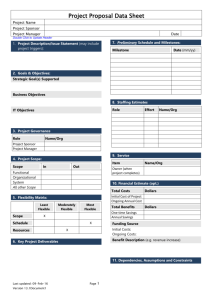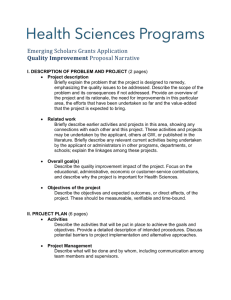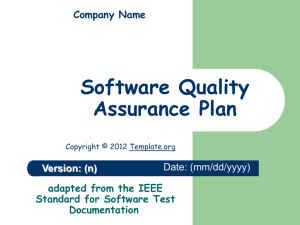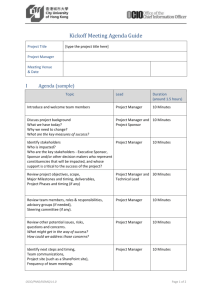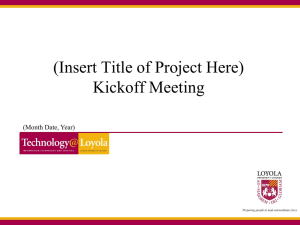software engineering paradigms
advertisement
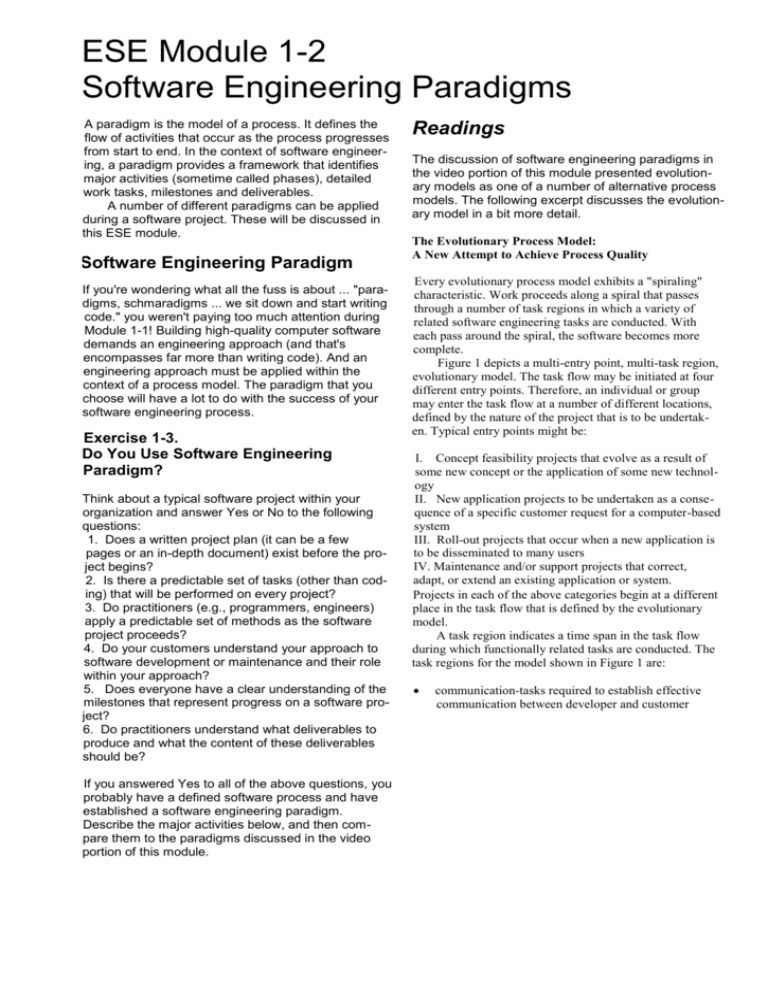
ESE Module 1-2 Software Engineering Paradigms A paradigm is the model of a process. It defines the flow of activities that occur as the process progresses from start to end. In the context of software engineering, a paradigm provides a framework that identifies major activities (sometime called phases), detailed work tasks, milestones and deliverables. A number of different paradigms can be applied during a software project. These will be discussed in this ESE module. Software Engineering Paradigm If you're wondering what all the fuss is about ... "paradigms, schmaradigms ... we sit down and start writing code." you weren't paying too much attention during Module 1-1! Building high-quality computer software demands an engineering approach (and that's encompasses far more than writing code). And an engineering approach must be applied within the context of a process model. The paradigm that you choose will have a lot to do with the success of your software engineering process. Exercise 1-3. Do You Use Software Engineering Paradigm? Think about a typical software project within your organization and answer Yes or No to the following questions: 1. Does a written project plan (it can be a few pages or an in-depth document) exist before the project begins? 2. Is there a predictable set of tasks (other than coding) that will be performed on every project? 3. Do practitioners (e.g., programmers, engineers) apply a predictable set of methods as the software project proceeds? 4. Do your customers understand your approach to software development or maintenance and their role within your approach? 5. Does everyone have a clear understanding of the milestones that represent progress on a software project? 6. Do practitioners understand what deliverables to produce and what the content of these deliverables should be? If you answered Yes to all of the above questions, you probably have a defined software process and have established a software engineering paradigm. Describe the major activities below, and then compare them to the paradigms discussed in the video portion of this module. Readings The discussion of software engineering paradigms in the video portion of this module presented evolutionary models as one of a number of alternative process models. The following excerpt discusses the evolutionary model in a bit more detail. The Evolutionary Process Model: A New Attempt to Achieve Process Quality Every evolutionary process model exhibits a "spiraling" characteristic. Work proceeds along a spiral that passes through a number of task regions in which a variety of related software engineering tasks are conducted. With each pass around the spiral, the software becomes more complete. Figure 1 depicts a multi-entry point, multi-task region, evolutionary model. The task flow may be initiated at four different entry points. Therefore, an individual or group may enter the task flow at a number of different locations, defined by the nature of the project that is to be undertaken. Typical entry points might be: I. Concept feasibility projects that evolve as a result of some new concept or the application of some new technology II. New application projects to be undertaken as a consequence of a specific customer request for a computer-based system III. Roll-out projects that occur when a new application is to be disseminated to many users IV. Maintenance and/or support projects that correct, adapt, or extend an existing application or system. Projects in each of the above categories begin at a different place in the task flow that is defined by the evolutionary model. A task region indicates a time span in the task flow during which functionally related tasks are conducted. The task regions for the model shown in Figure 1 are: communication-tasks required to establish effective communication between developer and customer 1-2.2 ·· Essential Software Engineering planning--tasks required to define resources, timelines, and other project-related information risk assessment--tasks required to assess both technical and management risks engineering--tasks required to build one or more representations of the application installation-tasks required to test, install, and provide user support (e.g., documentation and training) customer evaluation--tasks required to obtain customer feedback based on evaluation of the software representations created during the engineering stage and implemented during the installation stage. Management and technical tasks are defined for each of the task regions. To accommodate the need for an adaptive process (e.g., one that adapts itself to the characteristics of the project at hand), the evolutionary model should define a number of task sets. Each task set contains software engineering tasks, milestones, and deliverables that have been chosen to meet the needs of different types of projects. Each task set must provide enough discipline to achieve high software quality. But at the same time, it must not burden the project team with unnecessary work. Although any number of task sets can be suggested, the following are typical: Casual. The process model does not apply to the project, but selected tasks may be applied informally and basic principles of software engineering must still be followed. Disciplined. The process model will be applied for the project with a degree of discipline that will ensure high quality and good application maintainability. Rigorous. All process model tasks, documents, and milestones will be applied to the project. High quality, good documentation, and long maintainability are paramount. Quick reaction. The process model will be applied for the project, but because of extremely tight time constraints, only those tasks essential to maintaining good quality will be applied. When necessary, "back-filling" (e.g., developing a complete set of documentation) will be accomplished after the application is delivered to the customer. The process model should provide a set of adaptation criteria that can be used to guide a project manager in selecting the right task set. Each adaptation criterion is assigned a grade that is chosen based on a set of project characteristics. Some suggested adaptation criteria follow: Size of project. This criterion can be estimated in work units (e.g., person-months) or product units (e.g., number of lines of code to be generated). Number of potential clients/customers. This criterion provides information on the potential market and, by inference, the amount of support required. Business criticality. This criterion provides an indication of the relative business impact of the project. Longevity. This criterion estimates the number of years that the application to be built will be in active use. Stability of requirements. This criterion indicates the degree to which software requirements are understood and will remain stable throughout the project. Ease of customer-developer communication. This criterion provides an indication of the ease with which communication can be conducted between customer and developer. It is often affected by the location of developer and customer. Maturity of technology. This criterion provides a relative indication of the risk associated with the technology to be implemented. Performance constraints. This criterion provides a relative indication of the overall performance demanded of the application and the risk associated with achieving it. Hardware and software environment. This criterion defines the maturity and risk associated with the hardware and software environment into which the application is to be placed. The Process Framework The software engineering paradigm becomes one part of the process model that establishes a framework for your software project. The detailed character of your framework will vary, depending on local requirements, the kinds of software that you develop and maintain, and a variety of other factors. In this portion of ESE Module 1-2, the basic attributes of the framework are discussed. Software Engineering Paradigms ·· 1-2.3 Exercise 1-4. Designing a Common Process Framework Using information presented in the video and further information contained in the next Readings section, outline a common process framework for your organization. Perform the following tasks: 1. Identify the framework activities that will be applicable for all projects. 2. Define the major tasks that are appropriate for each framework activity. 3. Define the deliverables that are associated with each task. 4. Indicate what milestones will be used and how quality will be assessed as a consequence of reaching each milestone. Discuss your work with colleagues to obtain construetive criticism of your process model. Readings Before any organization can succeed in establishing effective software engineering practices, it must develop a common process framework. The following excerpt from A Manager's Guide to Software Engineering describes the attributes of a common process framework and proposes at set of questions that can serve as a prototype for selecting a framework and the technologies that populate it. The common process framework encompasses a common set of tasks, milestones and deliverables that establish the criteria for task completion at each step in the software engineering process. Organizational responsibility is defined for each deliverable. Reviews are conducted to confirm completion. The framework also incorporates the activities and responsibilities of quality assurance and configuration management. A common process framework should be easily adapted to different technical methods (e.g., analysis, design or testing methods) that are used for information system development. It establishes milestones (checkpoints) and deliverables for all projects and should be used for both new work and maintenance. While a minimum set of document deliverables are necessary at each framework checkpoint, the formats can be tailored to meet organizational and project needs as long as the intent of the common deliverable is met. A combination of a common framework, a conforming (to the intent of the common framework) set of technical · methods, and a set of conforming (to the intent of the common framework) deliverables define the software engineering process. In order to develop an appropriate common process framework, it is important to establish a set of criteria for the framework that your organization can live with. The following criteria should get you started: 1. The process model should define tasks, milestones and deliverables in a way that will guide project managers in their work. 2. The process model should be adaptable. That is, it should provide a framework for both large and small projects. 3. The process model should be applicable to both new development and maintenance work. 4. The process model should demand appropriate documentation, but should not bury developers/maintainers under an avalanche of documents. 5. The process model should serve as a first step toward ther development of software engineering standards. You goal is to select a set of methods that will complement the software engineering tasks chosen as part of a common process framework. To do this, you can begin with the following criteria that I have listed for each of the major methods areas. You should supplement these with criteria of your own: Analysis Does the analysis method support facilitated application specification with customers? Does the analysis modeling approach support a graphical notation that is widely used and understood? Are data, functional, and behavioral modeling supported? Is partitioning of all models supported? · Does the method lead directly to (1) a specification or (2) a prototype? Is the model that is created capable of being mapped into a design? Is the method supported by a number of different CASE tools supplied by different vendors on different platforms? Design Does the design method support data design, architectural design, and procedural design? Does the design modeling approach support a graphical notation that is widely used and understood? Are design fundamentals such as support for abstraction, refinement, functional independence, or modularity directly implemented using the method? Are design quality criteria explicitly stated? Does the design method result in the derivation of reusable components? Is the method supported by a number of different CASE tools supplied by different vendors on different platforms? Programming Languages and 4GLs Are the programming languages that have been chosen best for your application domain? Are the programming languages that have been cho- 1-2.4 ·· Essential Software Engineering sen best for your design approach? Are tools available for automatically generating source code? Does the language enable you to maintain coding style standards? Are the languages supported by a number of different CASE tools supplied by different vendors on different platforms? Testing Do the testing methods chosen support both black box and white box testing philosophies? Are the testing methods supported by CASE tools? Are the testing methods amenable to automated management by CASE tools? Do the testing methods provide path and condition coverage? Are the test methods consistent with the testing strategy specified in the common process framework? Reengineering Maintenance · Can the chosen analysis/design/testing methods be used during maintenance activities? How must they be modified, if at all? Are specialized tools available to support re-engineering methods? Software Quality Assurance Do the SQA methods enable quality checking after each major software engineering step? Do the SQA methods support the collection of quantitative data? Are the methods to be applied by an independent group? Are they easily learned? Is the formal technical review (FTR approach that has been chosen well suited to the culture and personalities of the organization's staff? Does the FTR method demand record keeping? Software Configuration Management Do the methods for SCM provide the procedural controls implied by the process framework? Is SCM an integral part of any CASE repository? Are the SCM methods supported by a number of different CASE tools supplied by different vendors on different platforms? Project Management Are cost estimation methods predicated on the collection of historical data? Are cost estimates to be derived using two different and independent methods? Is there a way of assessing the risks inherent in a software project? Do scheduling methods make use of the tasks implied in the common process framework? Are the project management methods supported by a number of different CASE tools supplied by different vendors on different platforms? Post-Test, Module I-2 This post-test has been designed to help you assess the degree to which you've absorbed the information presented in this ESE Module. Software Engineering Paradigms 1. If requirements are well defined and there is little likelihood that changes will occur, the simplest model to implement is: a. the classic lifecycle b. prototyping c. the spiral model d. formal methods 2. One of the problems associated with the linear, sequential paradigm is: a. it doesn't accommodate change particularly well b. it doesn't have well defined milestones c. it requires the use of structured methods d. it can't be used when empirical estimation methods are applied 3. The prototyping model can be used when: a. requirements are uncertain and the software is amenable to prototyping b. the customer demands quick turn around c. testing is unimportant d. it can always be used, regardless of the problem to be solved 4. When an evolutionary model is used: a. the project plan will evolve b. the design will evolve c. the program will evolve d. all of the above 5. What happens as a project moves outward on the spiral? a. risk is reduced b. the project moves closer to completion c. changes will not occur d. none of the above 6. The cube model is a sophisticated version of the evolutionary model because: a. it moves toward more detail as time passes b. it flattens the project organizationaI structure c. it accommodates multiple, asynchronous project activities d. it demands more iterations prior to completion Software Engineering Paradigms ·· 1-2.5 7. The reuse model is appropriate for object-oriented projects because: a. it supports object-oriented programming b. it accommodates evolutionary development and the use of a class library c. it has well-defined milestones d. it supports structured methods 8. The clean room model makes use of formal methods. This means that: a. proof of correctness will be used b. specification will be represented mathematically c. inspections will be conducted d. all of the above 9. A process framework will establish: a. a set of activities that will be used on every project, no matter what! b. a set of activities that should be used on every project c. a set of activities that may be used on every project, at the discretion of the individual project manager d. a set of activities that are recommended for use 10. The task set must be adaptable because: a. different projects require different skills b. different projects require different tasks to get the job done effectively c. data, function, and behavior must be adequately modeled d. the task set should not be adaptable! 11. All other things being equal, a large project would have: a. more framework activities than a smaller project b. fewer framework activities than a smaller project c. different framework activities from a smaller project d. an identical set of framework activities as a smaller project 12. All other things being equal, a large project would have a. fewer tasks, milestones, and deliverables than a smaller project b. more tasks, milestones, and deliverables than a smaller project c. an identical set of tasks, milestones, and deliverables as a smaller project d. there's really no way to know Copyright 1995 R.S. Pressman & Associates, Inc. No part of this material may be electronically copied, transmitted, or posted without the express written permission of R.S. Pressman & Associates, Inc. These materials have been posted on the Local Web Server of the Department of Computer Science with permission of R.S. Pressman & Associates, Inc. and are for use only by students registered for DCS/235 at Queen Mary and Westfield College
